Welcome to all msoms members Today we are going to introduce a unique topic
in here It will cover several countries around the world , so the members who
would like to register in this Encyclopedia Just send me a message about what
country would like to choose in order to write your name and country and to
avoid some random replies and make it more organized
(على الخاص)
This Encyclopedia what will cover?L
Any country in the world.
What's the main features of this country? L
Covers :
Brief introduction and may include why country named as ....... because (of)
about that country: its name (e.g. was derived or taken from ...... and /or It's
famous in / for (something) and /or the largest / smallest
country in terms of area / population / etc ... ( When available)
Country Name.
Flag.
Anthem.
Area : in numbers 260,000 km square.
Population and Density.
Capital.
(National) languages.
President .
Currency.
Nearby Countries / by land or sea borders :
e.g. It has borders for example with .... and ... and etc / OR it has maritime (sea) borders with ..... .
It's preferred to have a map to show such countries.
Nearby Seas or Oceans (If available): related to prior point .
-Languages.
- Religion.
-Education.
- Culture.
- Country divisions.
- Country's geography : hills /mountains / volcanoes /
Climate
Renowned Characters: such famous cities / food /
sports / art etc
- If one of points is not existent just skip to next one and so on .
- Add pictures and details as much as you can to beautify your country. (but it's not a rule when you don't wish).
-Please If you have any questions or you like to join us just send me a message and before this make sure that your country is not listed on ones that have been written below.
The topic you choose is due 3 weeks at most from day of your choosing or
your topic will be gone to other members .r
green : the topic is covered
grey : the topic is pending ( not finished yet)
Countries covered so far :
Country : Member:
- Switzerland. Mahbabood
Vatican City. Ls460L-
Geographic Encyclopedia
[ منتدى اللغة الإنجليزية ]
النتائج 1 إلى 2 من 2
الموضوع: Geographic Encyclopedia
-
11-2-2011 09:56 PM #1
 Geographic Encyclopedia
Geographic Encyclopedia
التعديل الأخير تم بواسطة Ls460L ; 26-4-2011 الساعة 05:06 PM
-
12-2-2011 12:41 AM #2


- تاريخ التسجيل
- Apr 2008
- المـشـــاركــات
- 8,616
- الــــدولــــــــة
- السعودية
- الــجـــــنــــــس
- ذكر
الـتـــقـــــيـيــم:









 مجموع الاوسمة: 48
مجموع الاوسمة: 48 Switzerland
Switzerland

Country name
Switzerland (officially the Swiss Confederation)
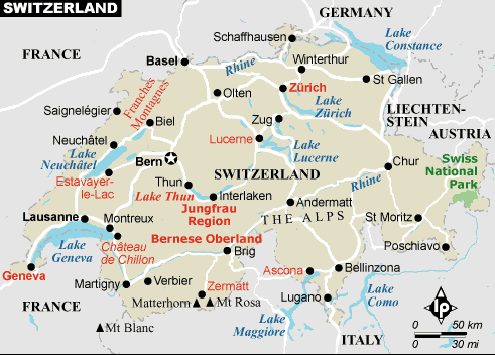

Flag
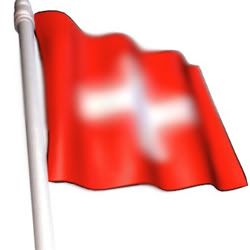

Area
Euorope
Switzerland is a landlocked country geographically divided between the Alps, the Central Plateau and the Jura, spanning an area of 41,285 km2 (15,940 sq mi). While the Alps occupy the greater part of the territory

Population and Density
the Swiss population of approximately 7.8 million people concentrates mostly on the Plateau, where the largest cities are to be found. Among them are the two global cities and economic centres of Zurich and Geneva.

Capital
Bern

(National) languages
German
French
Italian
Romansh

President
Micheline Calmy-Rey

Currency
Euro

Nearby Countries / by land or sea borders
France west
Germany north
Italy south
Austria east

Religion
Christianity

Culture
Three of Europe's major languages are official in Switzerland. Swiss culture is characterised by diversity, which is reflected in a wide range of traditional customs. A region may be in some ways strongly culturally connected to the neighbouring country that shares its language, the country itself being rooted in western European culture.

The linguistically isolated Romansh culture in eastern Switzerland constitutes an exception, it survives only in the upper valleys of the Rhine and the Inn and strives to maintain its rare linguistic tradition.
Switzerland is home to many notable contributors to literature, art, architecture, music and sciences. In addition the country attracted a number of creative persons during time of unrest or war in Europe. Some 1000 museums are distributed through the country; the number has more than tripled since 1950. Among the most important cultural performances held annually are the Lucerne Festival, the Montreux Jazz Festival and the Locarno International Film Festival.
Alpine symbolism has played an essential role in shaping the history of the country and the Swiss national identity. Nowadays many mountain areas have a strong highly energetic ski resort culture in winter, and a hiking (wandering) culture in summer. Some areas throughout the year have a recreational culture that caters to tourism, yet the quieter seasons are spring and autumn when there are fewer visitors and a higher ratio of Swiss. A traditional farmer and herder culture also predominates in many areas and small farms are omnipresent outside the cities. Folk art is kept alive in organisations all over the country. In Switzerland it is mostly expressed in music, dance, poetry, wood carving and embroidery. The alphorn, a trumpet- like musical instrument made of wood, has become alongside yodeling and the accordion an epitome of traditional Swiss music.

Country's geography
Extending across the north and south side of the Alps, Switzerland encompasses a great diversity of landscapes and climates on a limited area of 41,285 square kilometres (15,940 sq mi). The population is about 7.8 million, resulting in an average population density of around 190 people per square kilometre (485/sq mi). The more mountainous southern half of the country is far more sparsely populated than the northern half. In the largest Canton of Graubünden, lying entirely in the Alps, population density falls to 27 /km² (70 /sq mi).
Contrasted landscapes between the Matterhorn area in the high Alps, the Sanetsch region and the plateau at Lake Lucerne
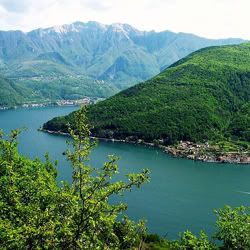
Switzerland lies between latitudes 45° and 48° N, and longitudes 5° and 11° E. It contains three basic topographical areas: the Swiss Alps on the south, the Central Plateau or middleland, and the Jura mountains on the north. The Alps are a high mountain range running across the central-south of the country, comprising about 60% of the country's total area. Among the high valleys of the Swiss Alps many glaciers are found, totalling an area of 1,063 square kilometres. From these originate the headwaters of several major rivers, such as the Rhine, Inn, Ticino and Rhone, which flow in the four cardinal directions into the whole of Europe. The hydrographic network includes several of the largest bodies of freshwater in western Europe, among which are included Lake Geneva, Lake Constance and Lake Maggiore. Switzerland has more than 1500 lakes, and contains 6% of Europe's stock of fresh water. Lakes and glaciers cover about 6% of the national territory.
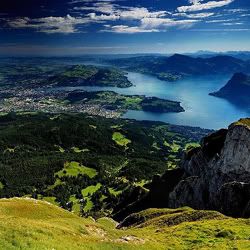
About a hundred of Switzerland's mountain peaks are close to or higher than 4,000 metres (13,000 ft). At 4,634 m (15,203 ft), Monte Rosa is the highest, although the Matterhorn (4,478 m/14,692 ft) is probably the most famous. Both are located within the Pennine Alps in the canton of Valais. The section of the Bernese Alps above the deep glacial Lauterbrunnen valley, containing 72 waterfalls, is well known for the Jungfrau (4,158 m/13,642 ft) and Eiger, and the many picturesque valleys in the region. In the southeast the long Engadin Valley, encompassing the St. Moritz area in canton Graubünden, is also well known; the highest peak in the neighbouring Bernina Alps is Piz Bernina (4,049 m/13,284 ft).
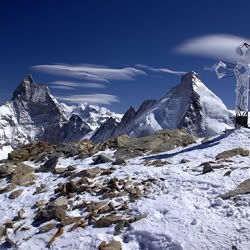
The more populous northern part of the country, comprising about 30% of the country's total area, is called the Middle Land. It has greater open and hilly landscapes, partly forested, partly open pastures, usually with grazing herds, or vegetables and fruit fields, but it is still hilly. There are large lakes found here and the biggest Swiss cities are in this area of the country.[41] The largest lake is Lake Geneva (also called Lac Léman in French), in western Switzerland. The Rhone River is both the main input and output of Lake Geneva.
Climate
Contrasted climates between the most glaciated area in western Eurasia (Aletsch Glacier), the cold temperate Jura (Vallée de Joux) and the southern canton of Ticino (Lake Lugano)
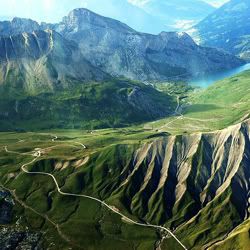
The Swiss climate is generally temperate, but can vary greatly between the localities, from glacial conditions on the mountaintops to the often pleasant near Mediterranean climate at Switzerland's southern tip. Summers tend to be warm and humid at times with periodic rainfall so they are ideal for pastures and grazing. The less humid winters in the mountains may see long intervals of stable conditions for weeks, while the lower lands tend to suffer from inversion, during this periods, thus seeing no sun for weeks.

A weather phenomenon known as the föhn (with an identical effect as the chinook wind) can occur at all times of the year and is characterised by an unexpectedly warm wind, bringing air of very low relative humidity to the north of the Alps during rainfall periods on the southern face of the Alps. This works both ways across the alps but is more efficient if blowing from the south due to the steeper step for oncoming wind from the south. Valleys running south to north trigger the best effect. The driest conditions persist in all inner alpine valleys that receive less rain because arriving clouds lose a lot of their content while crossing the mountains before reaching these areas. Large alpine areas such as Graubünden remain drier than pre-alpine areas and as in the main valley of the Valais wine grapes are grown there.
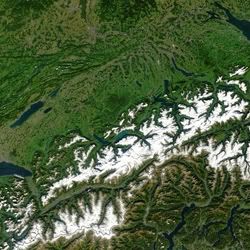
The wettest conditions persist in the high Alps and in the Ticino canton which has much sun yet heavy bursts of rain from time to time. Precipitation tends to be spread moderately throughout the year with a peak in summer. Autumn is the driest season, winter receives less precipitation than summer, yet the weather patterns in Switzerland are not in a stable climate system and can be variable from year to year with no strict and predictable periods.
Environment
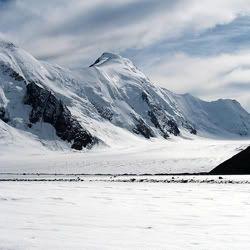
Switzerland's ecosystems can be particularly fragile, because of the many delicate valleys separated by high mountains, often forming unique ecologies. The mountainous regions themselves are also vulnerable, with a rich range of plants not found at other altitudes, and experience some pressure from visitors and grazing. The climatic, geological and topographical conditions of the alpine region make for a very fragile ecosystem that is particularly sensitive to climate change.

Renowned Characters
The cuisine of Switzerland is multi-faceted. While some dishes such as fondue, raclette or rösti are omnipresent through the country, each region developed its own gastronomy according to the differences of climate and languages. Traditional Swiss cuisine uses ingredients similar to those in other European countries, as well as unique dairy products and cheeses such as Gruyère or Emmental, produced in the valleys of Gruyères and Emmental. The number of fine-dining establishments is high, particularly in western Switzerland.
Chocolate had been made in Switzerland since the 18th century but it gained its reputation at the end of the 19th century with the invention of modern techniques such as conching and tempering which enabled its production on a high quality level. Also a breakthrough was the invention of milk chocolate in 1875 by Daniel Peter. The Swiss are the world's largest consumers of chocolate.
The most popular alcoholic drink in Switzerland is wine. Switzerland is notable for the variety of grapes grown because of the large variations in terroirs, with their specific mixes of soil, air, altitude and light. Swiss wine is produced mainly in Valais, Vaud (Lavaux), Geneva and Ticino, with a small majority of white wines. Vineyards have been cultivated in Switzerland since the Roman era, even though certain traces can be found of a more ancient origin. The most widespread varieties are the Chasselas (called Fendant in Valais) and Pinot Noir. The Merlot is the main variety produced in Ticino.

sports
Skiing, snowboarding and mountaineering are among the most popular sports in Switzerland, the nature of the country being particularly suited for such activities. Winter sports are practiced by the natives and tourists since the second half of the 19th century with the invention of bobsleigh in St. Moritz. The first world ski championships were held in Mürren (1931) and St. Moritz (1934). The latter town hosted the second Winter Olympic Games in 1928 and the fifth edition in 1948. Among the most successful skiers and world champions are Pirmin Zurbriggen and Didier Cuche.
Spengler Cup in Davos
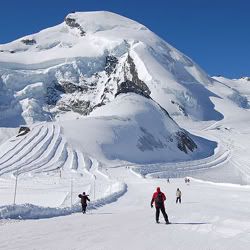
Many Swiss are fans of football and the national team or 'Nati' is widely supported. Switzerland was the joint host, with Austria, of the Euro 2008 tournament. Many Swiss also follow ice hockey and support one of the 12 clubs in the League A. In April 2009, Switzerland hosted the 2009 IIHF World Championship for the 10th time. The numerous lakes make Switzerland an attractive place for sailing. The largest, Lake Geneva, is the home of the sailing team Alinghi which was the first European team to win the America's Cup in 2003 and which successfully defended the title in 2007. Tennis has become increasely popular sport, and Swiss players such as Martina Hingis and Roger Federer have won multiple Grand Slams.
In a seven-year span, Roger Federer has won a record 16 Grand Slam singles titles
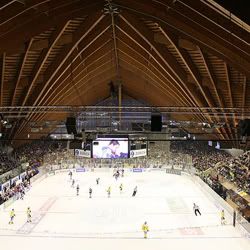
Motorsport racecourses and events were banned in Switzerland following the 1955 Le Mans disaster with exception to events such as Hillclimbing. However, this ban was overturned in June 2007. During this period, the country still produced successful racing drivers such as Clay Regazzoni, Jo Siffert and successful World Touring Car Championship driver Alain Menu. Switzerland also won the A1GP World Cup of Motorsport in 2007–08 with driver Neel Jani. Swiss motorcycle racer Thomas Lüthi won the 2005 MotoGP World Championship in the 125cc category.
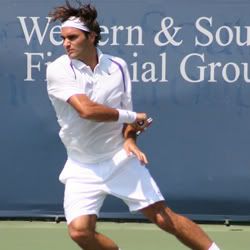
Traditional sports include Swiss wrestling or "Schwingen". It is an old tradition from the rural central cantons and considered the national sport by some. Hornussen is another indigenous Swiss sport, which is like a cross between baseball and golf. Steinstossen is the Swiss variant of stone put, a competition in throwing a heavy stone. Practiced only among the alpine population since prehistoric times, it is recorded to have taken place in Basel in the 13th century. It is also central to the Unspunnenfest, first held in 1805, with its symbol the 83.5 kg stone named Unspunnenstein.

Loading...





 رد مع اقتباس
رد مع اقتباس



المفضلات